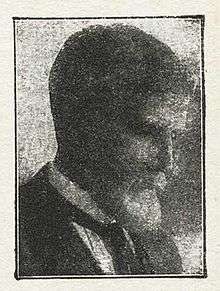T. O'Conor Sloane
Thomas O'Conor Sloane (November 21, 1851 – August 7, 1940) was a scientist, author and magazine editor, best known for his involvement with Hugo Gernsback and his Amazing Stories, initially as managing editor and then as the editor from 1929-38, as T. O'Conor Sloane.

Life and career
Sloane, an 1872 graduate of Columbia University, where he earned his Ph.D. in 1876, was a professor of natural sciences and higher mathematics at Seton Hall University[1][2] and held an A.M., an E.M., and a Ph.D. in electrical engineering, as well as an LL.D.
Sloane's best known invention was the Self-Recording Photometer for Gas Power – the first instrument to record mechanically on an index card the illuminating power of gas.[3][4][5][6] In 1877, he described a new process for determining sulphur in natural gas.[7][8]
Sloane was the author of The Standard Electrical Dictionary, first published in 1892, as well as How to become a Successful Electrician, Arithmetic of Electricity, Electricity Simplified, Electric Toy Making, Speed and Fun with Figures, Fortunes in Formulas, Motion Picture Projection, Liquid Air and the Liquefaction of Gases and numerous others; including a translation into English of Saint Francis of Assisi: A Biography written by Johannes Jorgensen. Sloane was also a prodigious contributor to many and various scientific and other publications such as the Encyclopædia Britannica, Alden's Cyclopedia and The Catholic Encyclopedia.
Sloane was the editor of Scientific American[9][10] and The Experimenter, an associate editor of Science and Invention and served on the editorial staff of several more popular periodicals such as Everyday Engineering Magazine. Sloane also contributed numerous articles to Scientific American. [11]
Amazing Stories
Sloane was involved with Amazing Stories from the very beginning, serving as Hugo Gernsback's managing editor. His own role in the magazine production grew and in 1929, he was named editor. Shortly after, in an editorial, he wrote that he believed that man would never achieve spaceflight. Nevertheless, he published first stories by luminaries such as Jack Williamson, John W. Campbell, Jr., Clifford D. Simak, E.E. "Doc" Smith and a first poem by Frederik Pohl.[12][13][14]
It is thought that Sloane collaborated with Gernsback in originating the term scientifiction which was superseded by science fiction to describe this genre, as suggested in part by the first issue of Amazing Stories.[15]
In 1938, publisher Ziff-Davis bought the magazine and moved its production to Chicago, naming Raymond A. Palmer as Sloane's successor.
Family
Sloane's son, T. O'Conor Sloane, Jr. became a well-known photographer; another son, John Eyre Sloane, an airplane factory owner, was married to Thomas Alva Edison's daughter Madeleine in 1914; their four sons were Edison's only grandchildren.[16]
Death
Sloane died in 1940 in New York City.[17]
Bibliography
- The Standard Electrical Dictionary (1892)
- How to become a Successful Electrician
- Arithmetic of Electricity
- Electricity Simplified
- Electric Toy Making
- Speed and Fun with Figures
- Fortunes in Formulas
- Motion Picture Projection
- Liquid Air and the Liquefaction of Gases
References
- Leonard, John (1907). Who's who in New York City and State, Issue 3 (Third ed.). New York City: L. R. Hamersly & Company. Retrieved 20 April 2020.
- Hoffmann's Catholic Directory, Almanac and Clergy List (Second Annual ed.). Chicago: Hoffmann Bros., Catholic Publishers. 1887. p. 261. Retrieved 20 April 2020.
- Leonard, John (1907). Who's who in New York City and State, Issue 3 (Third ed.). New York City: L. R. Hamersly & Company. p. 1194. Retrieved 19 April 2020.
- Leonard, John (1909). Who's who in New York City and State, Volume 4 (Fourth Biennial ed.). New York City: L. R. Hamersly & Company. p. 1197. Retrieved 19 April 2020.
- Marquis, Albert (1920). Who's who in America, Volume 11. Chicago: A. N. Marquis & Company. p. 2608. Retrieved 19 April 2020.
- Davis & Sanford (August 8, 1940). "Dr. T.O'C. Sloane, Scientist, Author". The New York Times. p. 19. Inventor of the Self-Recording Photometer for Gas Power Dies in South Orange. Wrote Technical Books. Ex-Associate Editor of Science and Invention Translated Foreign Works as Hobby.
- Hamersly, L. R. (1905). Who's who in New York City and State, Issue 2 (Revised ed.). New York City: L. R. Hamersly Company. p. 829. Retrieved 19 April 2020.
- Marquis, Albert (1920). Who's who in America, Volume 11. Chicago: A. N. Marquis & Company. p. 2608. Retrieved 19 April 2020.
- Leonard, John (1907). Who's who in New York City and State, Issue 3 (Third ed.). New York City: L. R. Hamersly & Company. Retrieved 19 April 2020.
- Leonard, John (1909). Who's who in New York City and State, Volume 4 (Fourth Biennial ed.). New York City: L. R. Hamersly & Company. Retrieved 19 April 2020.
- "STORIES BY T. O'CONOR SLOANE". Scientific American. Retrieved 19 April 2020.
- Page, Michael (2015). Frederik Pohl. University of Illinois Press. p. 22. ISBN 978-0-252-03965-2. Retrieved 19 April 2020.
- "An Elegy to Pohl". Amazing Stories. Retrieved 19 April 2020.
- Dozois, Gardner (2006). Nebula Awards Showcase 2006. New American Library (Penguin Group USA). ISBN 978-1-101-09819-6. Retrieved 19 April 2020.
- "A New Sort of Magazine", Amazing Stories: The Magazine of Scientifiction, Gernsback, Hugo, and T. O'Conor Sloane, eds., issue 1, page 3, April 1926.
- "Madeleine Edison Sloane". Retrieved 4 January 2019.
- Davis & Sanford (August 8, 1940). "Dr. T.O'C. Sloane, Scientist, Author". The New York Times. p. 19. Inventor of the Self-Recording Photometer for Gas Power Dies in South Orange. Wrote Technical Books. Ex-Associate Editor of Science and Invention Translated Foreign Works as Hobby.
External links
| Wikisource has original works written by or about: T. O'Conor Sloane |
- T. O'Conor Sloane at the Internet Speculative Fiction Database
- Works by T. O'Conor Sloane at Project Gutenberg
- Works by or about T. O'Conor Sloane at Internet Archive
- Works by T. O'Conor Sloane at LibriVox (public domain audiobooks)
